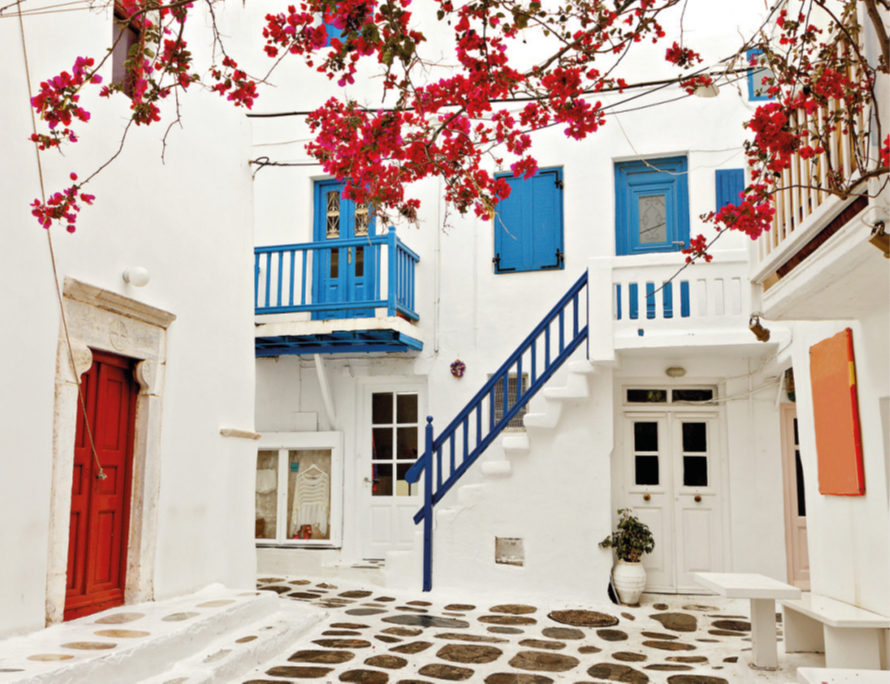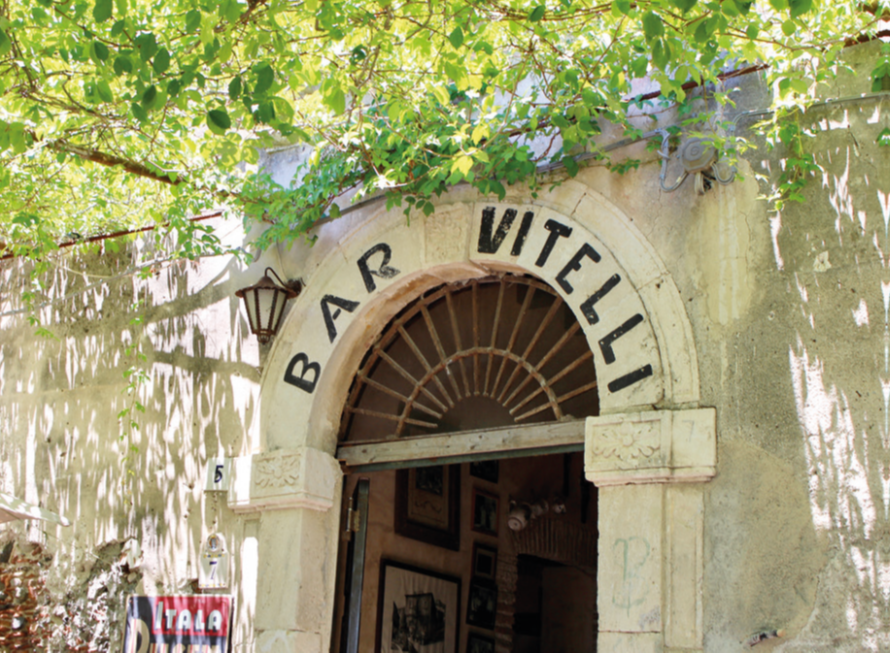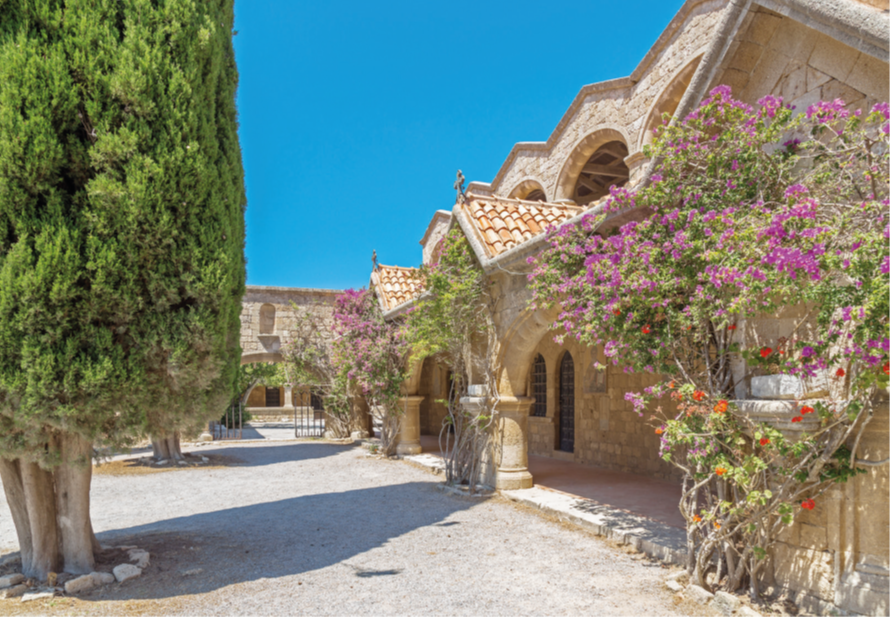What’s it Like on Board a Cruise Ship?
Norah Casey shares her experience on her first cruise and discovers the delights of island hopping, ancient ruins and life on board.
DAY 1 Rome (Civitavecchia), Italy
When we landed at the airport in Rome, we were met by Celebrity Cruise representatives in the baggage hall. Once we collected our luggage and made our way through customs, the bags were whisked away by the Celebrity crew and the next time we saw them was in our stateroom on board later that afternoon. ‑ e coach trip to the port at Civitavecchia was just under an hour and we enjoyed the ease of being transferred so seamlessly. After going through security at the port and organising our stateroom number and all-important
Celebrity key card we were finally climbing the ramp and boarding the Celebrity Reflection for our 11-day adventure. We shared a twin stateroom on level 9 and we had a nice balcony with a table and two chairs to watch the ocean go by. Although small (by hotel standards) the room was very cleverly designed with lots of storage space. It also had a good size shower, a television and mini-bar. It was a very large ship and we didn’t spend a lot of time in the room, so it was perfect for our needs.
Embarkation day truly separates out the seasoned cruisers from the novices. The newbies were crowding around the pool, bars, anywhere with food as the novelty of the sheer scale of the diff rent levels, bars, shops, casino, theatre, games room, library, multiple restaurants, sunny skies, smiling bar staff shaking Piña coladas – it was a sensory overload of excitement. Later I met a couple on their umpteenth cruise who had settled into the quietest corner of the ship for a glass of wine while the crazy cruise virgins were scoping the ship. “We always take the first few hours quietly until things calm down”, they told me.
And things did calm down (a lot) when the compulsory emergency drill was announced later that afternoon. It was a bit like herding sheep but there were plenty of crew members at every point to get us to our muster station. And surprisingly the muster drill was a mini feature film, a clever James Bond style spy thriller that managed to get all the safety points across in a funny engaging way. It got my attention anyway and it helped to ease the Titanic-esque jitters knowing what to do should the unmentionable happen.
Day 2 Sicily (Messina), Italy
After the early morning excitement of passing through the Strait of Messina (the narrow channel between the northeast of Sicily and the toe of Italy) our first port of call was Messina on the Sicilian side. This was a day for a shore excursion and we were heading to Don Corleone country to visit the villages and sights made famous by Francis Ford Coppola in the classic Godfather movies. Some iconic scenes were filmed at two tiny villages near Taormina, which between them were depicted as the town of Corleone. We headed away from the harbour dominated by the gilded seven-metre-tall statue of Stele Madonna della Lettera (Our Lady of the Letter) the patron saint of Messina. We drove over 20 kilometres finally heading up into the hills on narrow winding roads passing olive groves and trees heavy with oranges and lemons to the small village of Savoca. And although this little community is frequented by Godfather fans it still looks much like it did back in the 1970s when the film was shot. Our first stop was the 18th Century Bar Vitelli, where time has stood still over the decades.
The café and bar look just like it did in the movie except for the addition of memorabilia and old photographs from the filming haphazardly hung on an inside wall. And while the table that Michael Corleone, Fabrizio and Calo sat at is different, there is one exactly in the same place with the doorway adorned in the same beaded curtains. A little further up from the bar is the Church of Santa Lucia where Michael and Apollonia were wed. We lit candles and recreated their journey with the wedding party back down the small hill. Verdict: At ports like Messina it is not that easy to wander from the dockside into town, so this shore excursion was unusual and exciting for Godfather fans.
Day 3 Valletta, Malta
The most spectacular arrival into any harbour must be at the medieval city of Valletta in Malta. The beautifully preserved fortifications built by the Knights of Malta, the early morning sun creating a golden glow over the stone and the distinctive outlines of the Carmelite Church dome and St Paul's Anglican Cathedral spire. It truly is the home of Game of Thrones. I had never been to Malta before, so I was really looking forward to exploring the beautifully preserved capital. Valletta was nothing like I expected. For one thing the former European City of Culture has surreal white art installations through the old city where a glimpse of a stern Queen Victoria can be viewed over a gigantic stone head with a finger in one ear. I also expected it to be more British and even though there are odd legacies like red post boxes, the city is very much Maltese.
Founded in 1565, this World Heritage city offered refuge to pilgrims and crusaders en route to the Holy Land. The city has untold treasures from the glorious baroque church interiors to the colourful seafront balconies.
There are some 320 historic monuments crammed into the capital which UNESCO describes as “one of the most concentrated historic areas in the world”. But the city is full of surprises with contemporary design blending with the prehistoric temples and ancient ruins from its 7,000-year history.
Verdict: Valletta is one of the most unusual cities we visited. I would love to return to see some of the other cultural highlights outside the capital.
Day 5 Mykonos, Greece
After a day at sea we arrived at one of the most beautiful Greek islands. Stepping onto the balcony that morning was magical, transported overnight into this sun-drenched pristine white and blue oasis.
Mykonos looked glorious and I couldn’t wait to get off the ship to discover its beauty.
We left the harbour ahead of the crowds and delved into the backstreets. First stop was breakfast in a sunny taverna devouring creamy Greek yogurt drenched in honey (and it is nothing like what we buy here). We emerged into the whitewashed lanes with hues of blues and jade and bright pink flowers spilling over balconies and stairwells. It is no wonder Mykonos has become the Ibiza of the Cyclades, popular among some of the world's wealthiest and well-known celebrities.
Back in the '60s it was a magnet for the likes of Brigitte Bardot, Jacqueline Kennedy Onassis, and Grace Kelly. Now Leonardo DiCaprio, Paris Hilton, Ariana Grande, the Kardashians and Mariah Carey are regulars with Lindsay Lohen opening her own resort. We spent hours wandering through the maze of alleyways, surprised to find premium designer brands in little backstreets amid the classical Cycladic architecture. But for all that, Mykonos still feels more bohemian than glitzy. We were day trippers so didn’t get to experience the stunning sunset at Venice beach or the night clubs that stay open until dawn. But we found a lovely tranquil veranda for a late lunch and a glass of chilled rosé.
Verdict: I loved Mykonos, it was by far my favourite destination on the cruise and it is on the list for a return visit.
Day 6 Rhodes, Greece
We woke early as the ship docked at the beautiful medieval town of Rhodes with himself very excited to trace the origins of one the eight wonders of the ancient world.
Once conquered by the knights of Saint John of Jerusalem, Rhodes is the largest of the Dodecanese Islands and home to another gem on Dara’s hit list – the ruins of the Temple of Aphrodite. We had a lot of walking ahead. In oceanic terms this ancient Christian stronghold sits northeast of Crete, to the south and east of Athens and just off the coast of Turkey. The search was on to find where exactly the Colossus of Rhodes really stood as various theories hotly debated in the classics world put the gigantic statue of freedom astride the harbour gates or more towards the Acropolis higher up on the hills above this
UNESCO World Heritage town. Rhodes, with its sandstone architecture, Byzantine churches and mosques is quite different to the other Greek islands. We set off to wander the old town passing through the growing crowds in Jewish Martyrs Square to explore the quiet cobblestone streets. Our stroll took us by the Kahal Kadosh Shalom Synagogue in the Jewish quarter and on to the Grand Masters Palace.
There are treasures to be found in the old town, one of the most beautiful being the Street of the Knights lined with the ancient inns of different languages (tongues) of the Knights Hospitaller. Our sat nav was set however for the pretty and thankfully partially shaded Symi Square just inside the Eleftherias Gate (Gate of Freedom) where, nearby, we finally found the remains of the shrine to the goddess of love dating back to the 3rd Century BC. We sat for a while imagining this glorious Temple of Aphrodite from the ancient blocks and fallen columns scattered among the ruins, placing our hands on those ancient stones in wonder at how many other hands had touched those once majestic relics.
Verdict: I would return to Rhodes to visit some of the smaller and quieter villages.
Day 7 Santorini, Greece
The island I was most looking forward to visiting was Santorini and yet it didn’t turn out the way I imagined. We had been warned that there was only one way up and one way down to reach the town of Fira 200 metres at the top of this volcanic rock island and that was by a cable car gondola system that sometimes had queues of an hour or longer. The alternative was a long hike by foot or, worse, by donkey. As an animal lover I was horrified by the hordes of donkeys in the glaring sun huddled together waiting for the next gaggle of tourists to carry to the top. One overweight man with his feet dragging along the trail laughed loudly as the poor donkey hauled him up the steep paths. I lost quite a bit of time watching this and wondering at the stupidity of people who could use their own two legs to climb the path (it took us only 25 minutes).
Fira is very lovely but the narrow pathways are crowded so we set off on foot in the opposite direction and walked along the cliffs with some stunning views over the sea and the blue and white rooftops of Santorini. From this vantage point the island was picture postcard perfect and at the end of the path was a lovely restaurant perched on the edge of the cliff where we relaxed for an hour or so gazing out over the yachts and ships drifting in the beautiful azure blue seas.
Verdict: I will go back but since my return I have read many posts from residents and tourists about the mistreatment and abuse of the donkeys and I hope the Island takes note.
Day 8 Athens (Piraeus), Greece
Athens was inevitably going to be the highlight of the trip as the Acropolis has long been on Dara’s bucket list, so I can’t do justice to the excitement of us finally docking at Piraeus. There is a large map of the world on the wall of his bedroom and for as long as I can remember there is a pin on Athens, at the top of all the places he ever wanted to visit.
We headed out from the port in the early morning on a shore excursion (A Taste of Athens) for the 30-minute drive to the base of one of the world’s most iconic sights. Acropolises were plentiful in ancient Rome (the highest point of every city) but Athens boasts the best-preserved temples on this rocky outcrop overlooking the city. Setting aside the hordes of tourists who joined us on the climb (at times so crowded we shuffled through narrow passageways) being up close to these magnificent columns and ancient ruins was spectacular.
The Acropolis incorporates several buildings but only three main temples, the largest being the Parthenon which was built in honour of the goddess Athena who is the patron god and namesake of Athens itself. At the heart of the temple was a 42-foot-high statue of the goddess created from Chryselephantine (a mixture of gold and ivory). What makes the Parthenon unique is that it has both metopes (miniature statue-esque sculptures separated by three lines in the marble, also known as triglyphs) and a metre-high continuous frieze encircling the ceiling of the inner building. The second most significant temple is the Erechtheion, named after one of the kings of Athens.
It was also a temple to the god Poseidon and in honour of Athena. On the north side the distinctive Porch of the Maidens with its columns of six women (caryatids)
considered to represent the six priestesses of Athena is a beautifully preserved façade.
Even with the crowd, the unrelenting sun and the baking heat, the Acropolis is spectacular and while the Pantheon was the big draw, Dara and I wondered alone among some of the more deserted parts of the sites where restoration work was underway and ancient stones and columns lay where they had fallen.
Verdict: It was a wonderful day – hard to top and we will be back.
Day 10 Naples, Italy
Our last stop was the 2,800-year-old port city of Naples, the home of pizza but also of some amazing archaeological and historical wonders, so much so that the city framed by Mount Vesuvius is a UNESCO World Heritage Site. We decided to go further afield for our last day and opted for a whistle-stop tour of Positano, Sorento and Pompeii. We were on the road early to avoid the rush hour traffic and before long we were driving along the Amalfi coast with beautiful Positano carved out of the cliffs below. We only had one hour to venture down the steep steps and passageways to the shoreline and grab a quick espresso while watching the constant sea traffic ferrying people to and from this sophisticated resort. Positano was busy and far more touristy than I expected. It was always on my bucket list, but I am not sure I will be rushing back.
Next stop was Sorento and here we were in for a real treat. It’s a very lovely town with quirky artisan shops and cool little bars and restaurants. We had lunch at a beautiful historic hotel overlooking the bay and as we were just settling into a lovely corner table overlooking the ocean the waiter told us we were in luck. Within ten minutes of us sitting down, a spectacular flotilla of boats led by a large flower strewn fishing vessel headed out from the harbour for the annual Madonna De Grazia (Day of Thanks). All the boats in the bay were lined up respectfully in welcome and the townspeople of Sorento were out in force lining the ocean front to honour this patron saint of the town. And here we were on that day of all days at just the right moment to catch a bird’s eye view of one of the most important events in Sorento sitting at the best table in town. You couldn’t have planned it.
Last stop and by far the most eagerly anticipated was Pompeii. We headed out onto the large stone roads of this ancient city preserved forever when Mount Vesuvius erupted in AD79 and it was buried under an estimated 20 feet of volcanic ash.
Tragically many of the 11,000 inhabitants died nearly 2,000 years ago with no time to escape such was the speed and ferocity of the eruption. The forum, Roman baths, inscriptions, wells and beautiful tiling all there to see. Further excavations recommenced this year. It was a sobering visit. Fascinating in terms of the glimpse it offered into life in this important city but also steeped in sadness for all the lives that were lost. As we went to leave the huge site we took one last glance upwards at Mount Vesuvius, now calm and silent.
Verdict: I won’t return to Positano, I loved Sorento and I am so glad I saw Pompeii.
Day 11 Rome (Civitavecchia), Italy
Finally, it was time to leave our beautiful floating home and our departure was as painless and seamless as our arrival. Our luggage was collected the night before and left on the portside for us to collect, the bill was sent on electronically so there was no checking out queue. A great trip.
The next Italy and Greek Isles Cruise on Celebrity Reflection departs on May 6 and can be booked at celebritycruises.com.













